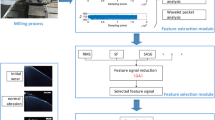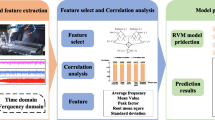Abstract
Tool wear has been a great impact on machining quality and machining efficiency during cutting. The serious tool wear will even lead to workpiece failure and catastrophic equipment failure. Accurate and effective tool wear monitoring is important to evaluate the degree of tool wear, replace tools in time, and promote the intelligent development of the manufacturing industry. To improve the accuracy of online prediction of tool wear, a new method based on whale optimization algorithm (WOA) optimized support vector machine (SVM) is proposed to predict the tool wear. Specifically, the multi-domain features of cutting force and vibration signals are extracted based on the time domain, frequency domain, and time–frequency domain, and the signal sensitive features closely related to tool wear are selected by the Pearson correlation coefficient method. SVM is applied to predict the evolution of tool wear. WOA is used to improve prediction accuracy by optimizing the internal parameters of SVM. By learning the nonlinear correlation between sensitive features and tool wear, a model for predicting tool wear based on WOA-SVM is constructed to predict the change of tool wear value. The effectiveness and prediction performance of the proposed method are verified by milling experiments. Results show that this method can predict tool wear value based on limited historical data information accurately and effectively. Compared with SVM prediction methods optimized by some common optimization algorithms (particle swarm optimization (PSO) and genetic algorithm (GA)), the prediction accuracy and stability are higher and the generalization is stronger. These findings may be of great significance for the improvement of machining quality and efficiency of parts, the stable operation of manufacturing system, and the intelligent development of manufacturing industry.










Similar content being viewed by others
Availability of data and materials
The data that support the results of this article are included within the article.
References
Cao XL, Shen B, Guo CY, Wang L (2018) A new era for the development of advanced manufacturing industry-intelligent manufacturing. Northern economy 369(8):58–60
Yousefi S, Zohoor M (2019) Effect of cutting parameters on thedimensional accuracy and surface finish in the hard turning of MDN250 steel with cubic boron nitride tool for developing aknowledge based expert system. Int J Mech Mater Eng 14(1):40712. https://doi.org/10.1186/s40712-018-0097-7
Liu XL, Liu SY, Li XB, Zhang BW, Yue CX, Liang SY (2021) Intelligent tool wear monitoring based on parallel residual and stacked bidirectional long short-term memory network. J Manuf Syst 60:608–619. https://doi.org/10.1016/j.jmsy.2021.06.006
Baig RU, Javed S, Khaisar M, Shakoor M (2021) Development of an ANN model for prediction of tool wear in turning EN9 and EN24 steel alloy. Adv Mech Eng 13(6):1–14. https://doi.org/10.1177/16878140211026720
Caggiano A, Nele L (2018) Artificial neural networks for tool wear prediction based on sensor fusion monitoring of CFRP/CFRP stack drilling. Int J Autom Tech 12(3):275–281
Wiciak-Pikua M, Felusiak-Czyryca A, Twardowski P (2020) Tool wear prediction based on artificial neural network during aluminum matrix composite milling. Sensors 20(20):5798. https://doi.org/10.3390/s20205798
Twardowski P, Wiciak-Pikuła M (2019) Prediction of tool wear using artificial neural networks during turning of hardened steel. Materials 12(19):3091–3106. https://doi.org/10.3390/ma12193091
Bagga PJ, Makhesana MA, Patel HD, Patel KM (2021) Indirect method of tool wear measurement and prediction using ANN network in machining process. Materials Today Proceedings 44(6):1549–1554. https://doi.org/10.1016/j.matpr.2020.11.770
Wang WG (2017) Cutting tool wear condition monitoring based on artificial bee colony-BP neutral network algorithm. Journal of Mechanical Strength 39(6):1282–1287
Xu LH, Huang CZ, Li CW, Wang J, Liu HL, Wang XD (2020) Estimation of tool wear and optimization of cutting parameters based on novel ANFIS-PSO method toward intelligent machining. J Intell Manuf 32(1–4):77–90. https://doi.org/10.1007/s10845-020-01559-0
Zhang HY, Zhang C, Zhang JL, Zhou LS (2014) Tool wear model based on least squares support vector machines and Kalman filter. Prod Eng Res Devel 8(1–2):101–109. https://doi.org/10.1007/s11740-014-0527-1
Nie P, He C, Xu L, Cui KQ (2015) The prediction research of tool VB value based on principal component analysis and SVR. 2015 International Conference on Intelligent Systems Research and Mechatronics Engineering
Xiao PF, Zhang CY, Luo M, Liu WW (2018) Modeling method for tool wear prediction based on ADNLSSVM. China Mechanical Engineering 29(7):842–849
Gomes MC, Brito LC, Silva MBD, Duarte M (2021) Tool wear monitoring in micromilling using support vector machine with vibration and sound sensors. Precis Eng 67:137–151. https://doi.org/10.1016/j.precisioneng.2020.09.025
Wang TY, He HL, Wang GF, Leng YG, Xu YG, Li Q (2007) Fault diagnosis of rolling bearing based on empirical mode decomposition and least squares support vector machine. Chin J Mech Eng 43(4):88–92
Nie P, He C, Xu L, Li ZQ, Cui KQ (2015) Research on tool VB value prediction of optimized SVM based on genetic algorithm. Machine Tool & Hydraulics 43(11):43–45
Zhang KF, Yuan HQ, Nie P (2015) A method for tool condition monitoring based on sensor fusion. J Intell Manuf 26(5):1–16. https://doi.org/10.1007/s10845-015-1112-y
García-Nieto PJ, García-Gonzalo E, Vilán-Vilán JA, Segade A (2016) A new predictive model based on the PSO-optimized support vector machine approach for predicting the milling tool wear from milling runs experimental data. Int J Adv Manuf Technol 86(1–4):769–780. https://doi.org/10.1007/s00170-015-8148-1
Pandiyan V, Caesarendra W, Tjahjowidodo T, Tan HH (2018) In-process tool condition monitoring in compliant abrasive belt grinding process using support vector machine and genetic algorithm. J Manuf Process 31:199–213. https://doi.org/10.1016/j.jmapro.2017.11.014
Kong DD, Chen YJ, Li N, Chen DX (2019) Tool wear estimation in end-milling of titanium alloy using NPE and a novel WOA-SVM model. IEEE Trans Instrum Meas 69(7):5219–5232. https://doi.org/10.1109/TIM.2019.2952476
Safavi HR, Esmikhani M (2013) Conjunctive use of surface waterand groundwater: application of support vector machines (SVMs) and genetic algorithms. Water Resour Manag 27(7):2623–2644. https://doi.org/10.1007/s11269-013-0307-2
Shan ZD, Zhu FX (2018) Wear mechanism and prediction model of polycrystalline diamond tool in milling sand mould. Chin J Mech Eng 54(17):124–132
Shi DF, Gindy NN (2007) Tool wear predictive model based on least squares support vector machines. Mech Syst Signal Proc 21(4):1799–1814. https://doi.org/10.1016/j.ymssp.2006.07.016
Seyedali M, Lewis A (2016) The whale optimization algorithm. Adv Eng Softw 95(5):51–67
PHM Society (2010) 2010 PHM society conference data challenge. https://www.phmsociety.org/competition/phm/10
Chen N, Hao BJ, Guo YL, Li L, Khan AM, He N (2020) Research on tool wear monitoring in drilling process based on APSO-LS-SVM approach. Int J Adv Manuf Technol 108(1–4):1–11. https://doi.org/10.1007/s00170-020-05549-7
Huang ZW, Zhu JG, Lei JT, Li XR, Tian FQ (2019) Tool wear predicting based on multisensory raw signals fusion by reshaped time series convolutional neural network in manufacturing. IEEE Access 7:178640–178651. https://doi.org/10.1109/ACCESS.2019.2958330
Huang ZW, Zhu JG, Lei JT, Li XR, Tian FQ (2020) Tool wear predicting based on multi-domain feature fusion by deep convolutional neural network in milling operations. J Intell Manuf 31(9–12):1–14. https://doi.org/10.1007/s10845-019-01488-7
Razak NH, Chen ZW, Pasang T (2016) Progression of tool deterioration and related cutting force during milling of 718Plus superalloy using cemented tungsten carbide tools. Int J Adv Manuf Technol 86(9–12):3203–3216. https://doi.org/10.1007/s00170-016-8438-2
Acknowledgements
The authors are grateful to the anonymous reviewers for valuable comments and suggestions, which helped to improve this study.
Funding
This work was financially supported by National Natural Science Foundation of China (No. 52175394) and Joint guidance project of Heilongjiang Natural Science Foundation (No. LH2021E083).
Author information
Authors and Affiliations
Contributions
Study conception and design: Yaonan Cheng. Drafting of manuscript: Xiaoyu Gai. Method proposed and interpretation of data: Xiaoyu Gai and Yingbo Jin. Acquisition and analysis of data: Rui Guan, Mengda Lu, and Ya Ding.
Corresponding author
Ethics declarations
Ethics approval
Not applicable.
Consent to participate
The authors have consent to participate.
Consent for publication
The authors have consent to publish.
Competing interests
The authors declare no competing interests.
Additional information
Publisher's Note
Springer Nature remains neutral with regard to jurisdictional claims in published maps and institutional affiliations.
Rights and permissions
About this article
Cite this article
Cheng, Y., Gai, X., Jin, Y. et al. A new method based on a WOA-optimized support vector machine to predict the tool wear. Int J Adv Manuf Technol 121, 6439–6452 (2022). https://doi.org/10.1007/s00170-022-09746-4
Received:
Accepted:
Published:
Issue Date:
DOI: https://doi.org/10.1007/s00170-022-09746-4




